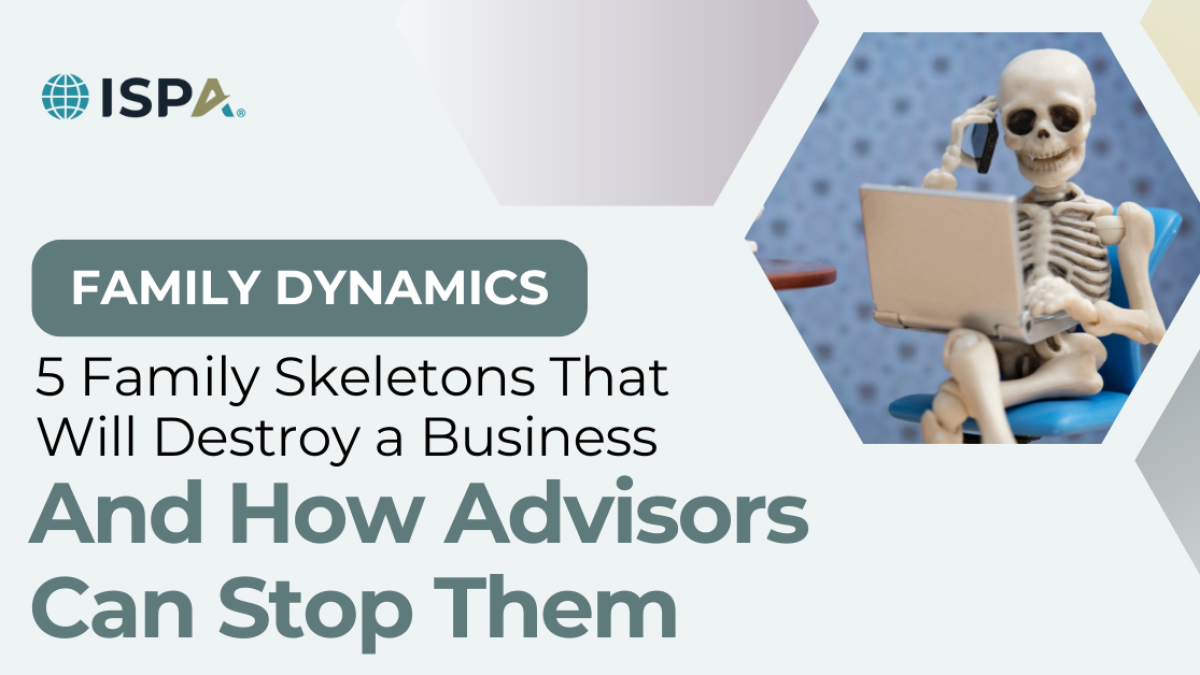5 Family Skeletons That Will Destroy a Business—And How Advisors Can Stop Them

Uncover family dynamics that can sabotage succession planning and learn strategies to guide clients through effective business transitions.
Family Business Succession Planning: Hidden Family Issues
When you think of Halloween, ghosts and skeletons might come to mind, but for family businesses, the real terrors are often lurking much closer to home. Hidden family issues can wreck even the best-laid succession plans. Believe it or not, 70% of family-owned businesses don’t make it to the second generation, and a huge part of that comes down to family conflicts and poor communication.
As an advisor, it’s crucial to help your clients uncover these “skeletons” before they wreak havoc on the business. What are the common family dynamics that can threaten succession planning? How can you guide your clients in confronting these hidden dangers before it’s too late? Let’s get into it.
The Skeletons in the Closet: Common Family Dynamics Issues
1. Sibling Rivalries: The Battle for the Throne
- Issue: In family businesses, sibling rivalry isn’t just about who got the bigger slice of cake at birthdays. It can become a battle for control over the family empire. Succession planning often brings these rivalries to the surface, with siblings fighting for leadership positions. One might feel entitled simply because they’re the eldest, while another might think they’ve worked harder and deserve the top spot.
- Frightening Consequence: When sibling rivalry goes unchecked, it can lead to power struggles that stall decision-making and cripple business operations. The result? Business stagnation or, worse, collapse.
2. Parental Favoritism: The Silent Haunt
- Issue: Another common skeleton is perceived or real parental favoritism. Sometimes, parents unknowingly (or knowingly) favor one child over another, which can create a nightmare when it comes to choosing a successor. One child may feel overlooked, while the “chosen one” might face resentment from their siblings.
- Scary Statistic: Only 12% of family businesses survive into the third generation, and one reason for this is poor preparation of successors—often caused by favoritism that leads to jealousy.
3. Emotional Baggage: Ghosts from the Past
- Issue: Old family wounds have a way of resurfacing when big decisions like succession planning come into play. Past conflicts between parents and children, or between siblings, can poison the process. Whether it’s unresolved arguments or longstanding grudges, these emotional “ghosts” can cloud judgment and prevent rational decision-making.
- Chilling Example: Consider a family business where unresolved issues between a parent and a child resurface during succession talks. These unspoken conflicts can lead to arguments, delays, and ultimately, the failure of the transition.
4. The Curse of Miscommunication
- Issue: One of the scariest things that can happen in a family business is miscommunication. Succession planning requires everyone to be on the same page, but when family members aren’t talking—or worse, making assumptions—things can go south quickly. Misunderstandings lead to confusion, frustration, and ultimately, family feuds.
- Frightening Example: Imagine a business owner who assumes their children are on board with their succession plan, only to discover—too late—that there were unspoken disagreements about who should take the reins. The result? A family feud and a business in chaos.
5. The Silence of Fear
- Issue: Fear of confrontation can also haunt succession planning. Some family members may avoid difficult conversations for the sake of preserving family harmony, hoping issues will resolve themselves. Unfortunately, silence only exacerbates the problem, and when the time comes for a leadership transition, the lack of clarity can lead to conflict.
- Chilling Outcome: Unspoken expectations about roles, responsibilities, and inheritance can lead to bitter disputes, jeopardizing both family relationships and the future of the business.
How Advisors Can Help Banish These Family Skeletons
Facilitate Family Governance
- Strategy: Creating a family governance structure, like setting up family councils or drafting a family business covenants, can do wonders for open communication. These frameworks help ensure that everyone has a voice and that decisions are made transparently. When family members know what is expected of each other, there’s less chance of nasty surprises down the road.
- Advisor’s Role: As a neutral third party, you can act as a mediator to help family members navigate difficult conversations and confront tough issues head-on. Your guidance can help turn potential conflicts into productive discussions that strengthen the family and the business.
- Pro Tip: Leveraging the insights of the Certified Succession Planner designation and resources available through the Succession News and Applied Practice (SNAP) resources provides you the tools and perspective to navigate complex family dynamics. If this is outside of your comfort zone, leverage an expert such as a family therapist or someone who specializes in mediating complex and emotional discussions.
Promote Regular Family Meetings
- Strategy: Regular family meetings provide a structured opportunity to discuss the business’s vision, succession plans, and any concerns family members might have. These meetings encourage transparency and help ensure that all family members are aligned with the business’s goals.
- Advisor Role - Set a Consistent Meeting Schedule: Establish regular family meetings, whether quarterly or annually, with a clear agenda that includes discussions on business goals, succession planning, and family dynamics. This ensures open communication and keeps everyone aligned on the long-term vision of the business.
Implement a Clear Growth and Succession Strategy
- Strategy: The importance of a well-documented and transparent succession strategy cannot be overstated. A clear plan outlines roles, responsibilities, and timelines, ensuring that everyone knows what to expect. It reduces ambiguity and can prevent future disputes.
- Advisor Role - Create a Succession Roadmap: Work with your clients to develop a detailed succession roadmap that outlines key roles, responsibilities, and timelines. Ensure it’s documented and regularly reviewed, so all family members know what to expect and potential conflicts can be addressed before they escalate.
- Pro Tip: Tools like the Succession Planning Assessment (SPA™) can help you and your clients identify potential family issues early on, allowing you to address them proactively.
Prioritize Family Harmony Alongside Business Success
- Strategy: Family harmony is just as important as business success when it comes to succession planning. If the family is on the same page, they’ll work together to achieve the business’s goals. But if there’s discord, it can jeopardize the business and the family relationships. Encourage your clients to see succession planning as a way to not only secure the business but also strengthen family bonds.
- Advisor Role - Encourage balanced discussions: Ensure that family members understand that both business goals and family harmony are equally important. Facilitate conversations that address family dynamics and business objectives simultaneously to foster unity and collaboration during the succession planning process.
- Key Takeaway: An effective transition strategy balances both business continuity and family harmony. Advisors with the Certified Succession Planner (CSP) designation gain valuable insights and access to SNAP resources—equipping them with implementation tools and strategies to help families navigate the complex intersection of family dynamics and business goals. If these challenges extend beyond your expertise, tap into your centers of influence network, including family therapists or governance experts, to provide your clients with the specialized support they need for a seamless leadership transition.
Don’t Be Afraid to Call in Outside Help
- Strategy: Some family dynamics may require more than just a well-crafted succession plan. If deep-rooted issues persist, it may be necessary to bring in external advisors, such as family therapists or governance experts, to help resolve conflicts and facilitate healthier communication patterns.
- Pro Tip - Collaborate with external experts: When family dynamics become too complex, don’t hesitate to bring in outside specialists such as family therapists, mediators, or governance consultants. Build a trusted network of professionals through your centers of influence to ensure your clients receive the expert guidance they need to resolve conflicts and strengthen communication during succession planning.

Don’t Let Family Skeletons Haunt Your Client’s Succession Plan
Family dynamics can be the hidden skeletons that undermine even the most thoughtfully designed growth and succession strategies. However, by guiding your clients to proactively establish governance frameworks, create mechanisms for open and safe communication, and maintain a well-structured, regularly updated succession plan, these skeletons can be put to rest. As an advisor, you have the ability to lead your clients through these tough conversations, ultimately helping them protect and secure their family legacy for future generations.
Don’t wait until these issues surface—start the conversation now. Leverage tools such as the Certified Succession Planner (CSP) designation, Succession Planning Assessment (SPA™), and Succession News and Applied Practice (SNAP) resources to identify hidden challenges and forge a clear path toward Succession Success™ for your clients.
Categories: : Family Dynamics
GROW YOUR ADVISORY PRACTICE WITH THE ISPA
Seamlessly implement cutting-edge tools and strategies for business advisory and succession planning. Focus on delivering tangible results that foster your clients' success and drive growth in your own business.
Are You Looking to Grow Your Practice?
Check Out These Free Downloads

16 HIDDEN BUSINESS OPPORTUNITIES
Multi-generational clients grow your business. Whether you are a lawyer, accountant, financial advisor, or consultant, we have a list of actionable strategies you can test today to motivate your clients to work with you long term.

12 QUESTIONS TO CREATE CLIENT OPPORTUNITIES
In this free resource of 12 powerful questions you can ask to identify client motivations and influence business owners to take action. You will have a better discussion with prospects & clients immediately.

20 YEAR
CASE STUDY
Want to get into the specifics of what it takes in succession planning? Gain insights into the inner-workings of a real long-term family business succession planning case study and a business engagement that was worth over $75,000 per year.

3 STRATEGIC PROJECT EXAMPLES
We outlined three of our best examples of projects you could learn from and potentially apply in your business. From objective to successful outcome, these family business examples help you build strategies.
JOIN OUR INSIDER UPDATES FOR EXCLUSIVE INSIGHTS
Access premium resources at no cost. Gain insights into cutting-edge strategies for client acquisition and retention, along with exclusive webinars designed to advance your advisory practice. Subscribe to our Insight Briefs and amplify your advisory impact.
 Succession Planning Resource
Succession Planning Resource 


